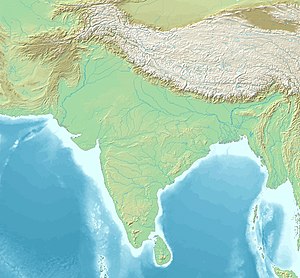| Battle of Chanderi | |||||||||
|---|---|---|---|---|---|---|---|---|---|
| Part of Mughal Conquests | |||||||||
 Illustration of the battle from Baburnama | |||||||||
| |||||||||
| Belligerents | |||||||||
| Mughal Empire | Chanderi Rajputs | ||||||||
| Commanders and leaders | |||||||||
| Babur | Medini Rai † | ||||||||
| Strength | |||||||||
| Unknown | 15,000 Garrison[2] | ||||||||
Location within South Asia | |||||||||
The Battle of Chanderi or Siege of Chanderi took place in the aftermath of the Battle of Khanwa in which the Mughal Emperor Babur (transliteration: Bābar) had defeated the Rajput Confederacy and firmly establish Mughal rule while crushing regrowing Rajput powers as the battle was fought for supremacy of Northern India between Rajputs and Mughals.[3] On receiving news that Rana Sanga had renewed war preparations to renew the conflict with him, Babur decided to isolate the Rana by inflicting a military defeat on one of his vassals Medini Rai who was the ruler of Malwa.[4][5] Consequently, in December 1527, taking a circumlocutious route Babur marched to the fortress of Chanderi in Malwa which was the capital of the kingdom of Malwa.[6] Upon reaching Chanderi, on 20 January 1528, Babur offered Shamsabad to Medini Rai in exchange for Chanderi as a peace overture but the offer was rejected by Rai.[7]
The outer fortress of Chanderi was taken by Babur's army at night, and the next morning the upper fort was captured. Babur expressed surprise that the upper fort had fallen within an hour of the final assault.[4]
Medini Rai organized the Jauhar ceremony during which Rajput women and children committed self-immolation to save their honour from the Mughals.[7] A small number of soldiers also collected in Medini Rai house and proceeded to slay each other in collective suicide. This sacrifice does not seem to have impressed Babur who does not express a word of admiration for the enemy in his autobiography.[4] Rather, as he had done after Khanwa, he ordered a tower of skulls—a practice formulated by Timur against opponent—to be erected in an act of barbarism.[5] The practice of constructing a tower of skulls was to record a monumental victory and also to terrorize opponents, according to Chandra. Babur had earlier used the same tactic against the Afghans of Bajaur.[5]
- ^ Chaurasia 2002, p. 157.
- ^ Sharma 1954, p. 42.
- ^ Sharma 1954, p. 8.
- ^ a b c Lane-pool, Stanley. "Babar". The Clarendon Press. Retrieved 12 June 2015.
- ^ a b c Chandra, Satish (2006). Medieval India: From Sultanat to the Mughals (1206–1526). Vol. 2. Har-Anand Publications.
- ^ Chaurasia 2002, p. 156.
- ^ a b Sharma 1954, p. 43.

